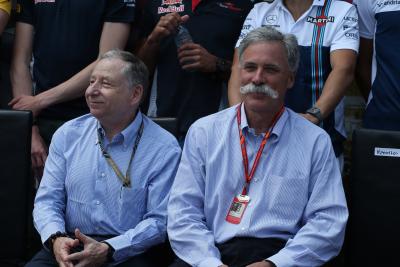The Liberty Thaw of F1's Cold War
Since Liberty took the reins of Formula 1 at the start of 2017, the sport’s new owners have been subject to all manner of thinkpieces on their first 100 days, their first year in the sport, and on the changes - or lack thereof - that Liberty have introduced.
Since Liberty took the reins of Formula 1 at the start of 2017, the sport’s new owners have been subject to all manner of thinkpieces on their first 100 days, their first year in the sport, and on the changes - or lack thereof - that Liberty have introduced.
Whatever your thoughts on podium DJs, boxing-style driver introductions, changes to race start times, and the precise definition of just what constitutes a grid girl, there is one area in which Formula 1 - the name adopted by the commercial rights holder (CRH) - has introduced unilaterally positive change: relations with the FIA.
After Max Mosley submitted to calls for his resignation - following that notorious submission of an entirely different nature - relations between the Federation and the CRH were somewhat fraught. Mosley and Bernie Ecclestone had grown Formula 1 together, working both combatively and symbiotically to shape the sport into the billion-dollar behemoth it is today.
When Liberty arrived, however, Ecclestone was promoted to chairman emeritus, a status the diminutive Briton said was “so high that when I look down, I can't see anything.” The triumvirate of Chase Carey, Sean Bratches, and Ross Brawn took over management of the sport, and immediately set out to build a collaborative relationship with the FIA.
Speaking at the FIA’s annual Sport Conference Week, this year held in Manila, Carey spoke highly of improved relations between the CRH and the regulatory body.
“In many ways, I think the partnership we have with the FIA is incredible,” Carey said. “They’ve been a great partner. They’ve certainly been a help to me. I came into this sport without the depth of knowledge that many have and certainly many of my colleagues did too. I think they’ve really helped, together as partners to try and grow the sport, again both for those competing in it as well as the fans who follow it.”
But a positive working relationship requires more than kindness, and the FIA and Formula 1 are working separately to achieve shared goals. One such goal is strengthening F1’s fanbase - and future - through the single-seater career ladder.
“The F2 and F3 initiatives are tremendously important,” Carey acknowledged. “It’s about creating that pyramid we’ve talked about to support the sport. We want to provide opportunities to drivers from around the world. It’s tremendously important. But also by having a structure and visibility to it, and enable fans to follow where the stars of tomorrow are coming from.
“They can engage and they can follow those promising, young stars, and watch them grow and climb that pyramid from Formula 3 to Formula 2 to Formula 1. I think it’s incredibly important for both the strength of the sport on the track and the strength of the sport with fans around the world.”
Clearly defining the single-seater career path has long been a central aim of Jean Todt’s FIA presidency. The Federation has been working with the national sporting associations (ASNs) among its member clubs to build grassroots motorsport around the world - not just in those countries already involved in motorsports across a range of categories.
According to Carey, who was speaking to a room filled with ASN representatives from around the world, Formula 1 as the CRH is also committed to supporting grassroots motorsport.
“It’s the future,” he said. “We didn’t have an organisation in place a year and a half ago that was capable of connecting every region. As I said early on, we’re still early days, but it’s tremendously important that we can engage with everybody here.
“I’m going to talk about F3, F2, and F1 where we’re directly involved. You’ve got to get the engagement much earlier than that, and we can’t do that ourselves. We can help provide some tools and some energies and some thoughts, certainly work with the FIA - they’ve been wonderful in terms of supporting the initiatives we’ve been trying to pursue in the last year.
“But ultimately it’s the people in this room that have the understanding of the local market. We find it with promoters as well. We need partners who understand the markets and how you tap into it, and the right way to go about developing the interest, both participation and fan-wise, in each market.”
Having spent nearly a decade covering this sport, throughout which the governing body and the commercial rights holder were engaged in a Cold War of sorts, Carey’s enthusiasm - coupled with the shared vision of how best to grow motorsport for mutual benefit - is the clearest sign yet seen that Liberty’s acquisition of F1 has been the dawning of a brave new world.


![Johann Zarco, LCR, Honda RC213V, 2024 San Marino MotoGP, Misano, action [Gold & Goose]](https://cdn.crash.net/styles/thumbnail/s3/2024-09/GnG_1166323_HiRes.jpg?itok=vpgrU7Q4)

![Jack Miller, KTM Factory Racing, KTM RC16, San Marino MotoGP, Misano, action [Gold & Goose]](https://cdn.crash.net/styles/thumbnail/s3/2024-09/GnG_1167624_HiRes.jpg?itok=iz7mA4EQ)


![Fabio Quartararo, Monster Energy Yamaha Racing, Yamaha M1, 2024 MotoGP, Misano Test, action [Gold & Goose]](https://cdn.crash.net/styles/thumbnail/s3/2024-09/GnG_1168928_HiRes.jpg?itok=fcYSole_)
![Toprak Razgatlioglu, ROKiT BMW Motorrad, BMW M 1000 RR, Magny-Cours, WorldSBK [Gold & Goose]](https://cdn.crash.net/styles/thumbnail/s3/2024-09/GnG_1165133_HiRes.jpg?itok=GD5SVNVG)

